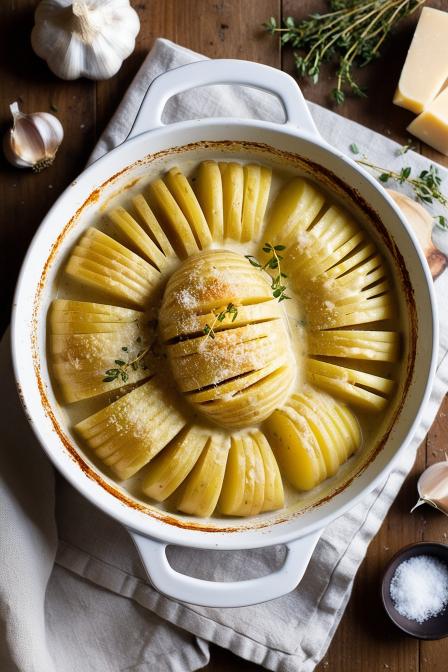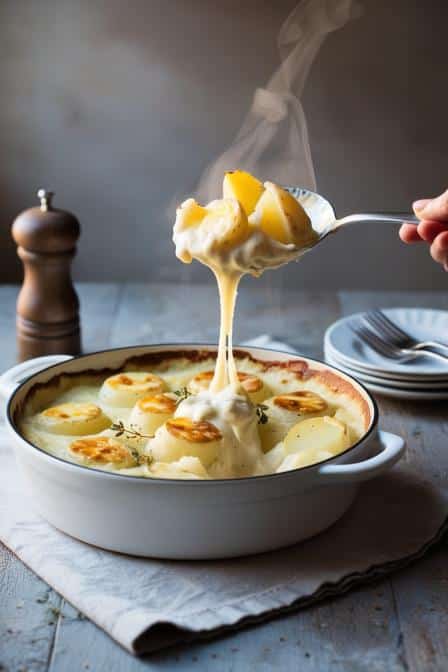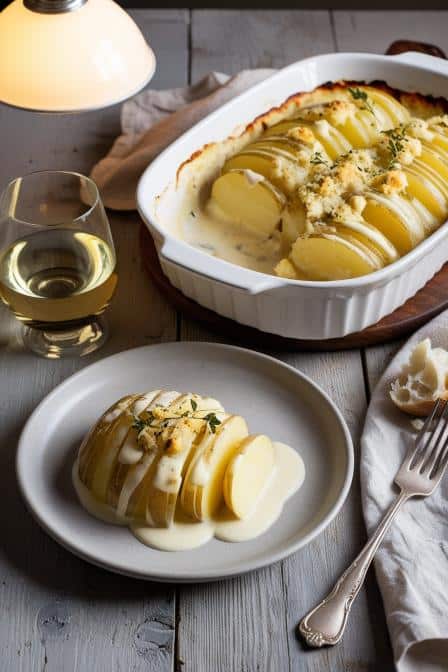There was this one winter—bone-chilling, wet, that sort of wind that eats through your coat no matter how thick—when I made creamy garlic sauce potatoes for a supper club gathering. Everyone brought fancy stuff: rack of lamb, some black cod with miso, even a soufflé that collapsed right on cue. But the potatoes? The humble, soft, saucy heap I slapped into a ceramic dish? Gone first. Not even a speck left to scrape. Someone literally licked the spoon.
So, what is this dish exactly? At first glance, it’s just potatoes and garlic in a sauce. But that’s like saying a croissant is just butter and dough. This dish is all about coaxing out the slow, subtle power of garlic, the lush richness of cream, and the way a starchy potato can absorb flavour like it was born to do just that. It’s peasant food dressed in velvet. Cozy, indulgent, totally irresistible. It works as a side, but let me tell you—many folks will eat it like a main.
It’s got French roots, maybe even Italian if you trace it through the garlic and cream traditions. It sits somewhere between a gratin and a stew. But the real magic’s in the method. Done right, it’s creamy but not watery, garlicky without harshness, and the potatoes hold just enough structure to stand up without falling apart like mashed mush.
Let’s get into it.
Ingredients & Substitutions
Getting the right ingredients is half the battle won. But not everyone lives near a farmer’s market or has access to heavy cream that tastes like actual cream. That’s fine. There’s room for flexibility, if you know what you’re doing.
Ingredient Table
| Ingredient | Purpose | Possible Substitutes | Expert Notes |
|---|---|---|---|
| Yukon Gold Potatoes | Creamy texture, holds shape | Russets (fluffier), Red Potatoes (firmer) | Avoid waxy varieties like fingerlings—they resist absorbing sauce. |
| Garlic (fresh cloves) | Flavor foundation | Roasted garlic, garlic confit, garlic paste | Fresh gives a bite; roasted gives depth and sweetness. |
| Heavy Cream (35–40% fat) | Sauce base, richness | Half & half (lighter), coconut cream (vegan) | Higher fat content prevents curdling during simmering. |
| Unsalted Butter | Adds fat and rounds out garlic flavor | Olive oil, plant-based butter | Butter browns beautifully with garlic. |
| Parmesan Cheese | Umami, salty kick | Grana Padano, Pecorino Romano, Nutritional yeast (vegan) | Adds body to the sauce, not just flavour. |
| Fresh Thyme | Herbal aroma | Rosemary, oregano, dried thyme (use less) | Dried is more intense; use 1/3 of the amount. |
| Salt & Pepper | Seasoning | Sea salt, white pepper for milder taste | Season at every stage, not just the end. |
| Vegetable or Chicken Stock | Dilutes cream, adds background depth | Water (if needed), mushroom broth (umami for veg version) | Don’t skip it—it lifts the whole dish. |
Some folks toss in onions, shallots, or even leeks. That’s not a crime. But garlic’s the lead singer here. Don’t drown her out.
Step-by-Step Instructions

1. Prep the Potatoes
Peel and slice your potatoes into 1/4-inch rounds. Don’t go thinner—they’ll fall apart. Too thick, and they won’t absorb the sauce properly. Rinse them once to remove surface starch, then pat dry. That’s key: wet potatoes will water down the sauce.
Common mistake: Tossing raw slices straight into cream. Nah. They’ll never cook evenly that way.
2. Sauté Garlic and Thyme in Butter
In a heavy-bottomed pan (cast iron or stainless, please no flimsy non-stick), melt butter over medium-low heat. Add smashed garlic cloves—don’t mince them. Let them sizzle, not fry. You want golden, not burnt. Toss in thyme. Smell that? That’s what your kitchen should always smell like.
3. Build the Sauce
Add the cream slowly. Bring up the heat just a notch until it simmers. Add a splash of stock, then toss in a small handful of grated parmesan. Stir gently. Taste. Adjust. You’re not making Alfredo sauce—this should coat the back of a spoon, not smother it.
4. Add Potatoes and Simmer
Lay the potato slices gently into the sauce. Don’t dump them in like gravel. Make sure they’re coated well. Cover the pan and let it all simmer for 20–25 minutes. Stir occasionally. Don’t overdo it, or you’ll mash everything into a gluey paste.
Tip: A gentle stir from the bottom every 5 minutes avoids sticking and scorching.
5. Finish in the Oven (Optional, but glorious)
Transfer to a baking dish. Top with a little more cheese. Broil for 5 minutes until bubbly and golden on top. That layer? That’s what separates a good dish from a masterpiece.
Cooking Techniques & Science
Garlic: Raw vs Cooked
Raw garlic is fiery. Cooked garlic is mellow, almost sweet. By slow-sautéing, we soften the bite and let its aromatics bloom. Burn it though, and the whole thing goes bitter—no coming back from that.
Cream and Cheese: Emulsion Matters
Ever had cream split into oily puddles? That’s because fat and liquid didn’t emulsify properly. Stir constantly. Keep heat moderate. Add cheese off-heat, not in the middle of a boil. Science 101.
Potato Starch: The Natural Thickener
Potatoes release starch as they simmer. This naturally thickens your sauce without needing flour. But over-stirring breaks them down and releases too much starch = gummy mess.
Tools That Matter
Use a mandoline if you want perfect, uniform slices. A heavy saucepan helps retain even heat—cheap ones scorch. Wooden spoon over metal; you’ll thank yourself when scraping the bottom gently.
How to Store & Reheat

Let leftovers cool completely before refrigerating in an airtight container. They’ll keep for up to 4 days. When reheating, add a splash of milk or cream to loosen things up. Microwave works, but stovetop is better. Oven is best. Bake at 180°C (350°F) for 10–15 minutes covered with foil.
Do not freeze—the cream splits and the texture gets all weird. Like spongy wallpaper paste. Just don’t.
Variations & Substitutions
- Vegan Version: Use coconut cream, olive oil, and nutritional yeast. Add a bit of miso paste for umami.
- Spicy Kick: Stir in crushed red pepper flakes or smoked paprika.
- Lighter Option: Swap heavy cream for half & half or even Greek yogurt—but whisk in off heat or it’ll curdle.
- Cheesy Overload: Add Gruyère or blue cheese crumbles.
- Add Protein: Stir in shredded chicken or bacon bits (yes please).
Serving & Pairing Suggestions
Serve it right out of the dish, hot and bubbling. Sprinkle with chives, parsley, or crispy shallots. Looks rustic, tastes luxe.
Pairs beautifully with:
- Roast chicken or duck
- Braised short ribs
- Pan-seared salmon
- A bitter green salad (arugula, radicchio)
- Dry white wine (Chardonnay or Viognier)
Want to go full comfort? Serve it with crusty sourdough and a glass of cider. Thank me later.
Best Time to Serve or Eat
This is a cold-weather dish. Period. Autumn, winter, early spring. Rainy days. Holiday dinners. Sunday suppers. Post-breakup meals. Midnight fridge raids. It doesn’t judge. It comforts.
You can even prep it a day ahead. In fact, it tastes better the next day after the garlic’s had time to seep into the potatoes like a slow whisper.
Conclusion
Creamy garlic sauce potatoes aren’t trendy. They’re not Instagram bait. They’re better. They’re the kind of dish that makes people close their eyes mid-bite. Simple, yes. But never plain.
The secret lies in balance—of flavor, texture, and technique. Don’t rush it. Don’t skimp on the garlic. Let the sauce speak. It will sing.
My final tip? Always taste at every stage. Garlic can vary. Creams can be different. Trust your palate, not just the recipe.
And maybe—just maybe—make a double batch. One for them, one for you.
FAQs
1. Can I make this dish ahead of time?
Yes, and it often tastes better the next day. Just reheat gently with a splash of cream or milk to restore texture.
2. What’s the best potato for this recipe?
Yukon Gold is king here. It holds shape but turns creamy. Avoid waxy varieties.
3. Can I use garlic powder instead of fresh garlic?
Technically yes, but… don’t. Fresh garlic gives depth, texture, and real aroma. Powder’s a shadow of the real deal.
4. Is this dish gluten-free?
Yes, if you don’t add flour. Most versions rely on potato starch and cream to thicken naturally.
5. Can I add meat or vegetables to it?
Totally. Bacon, spinach, mushrooms, or leftover chicken all work. Just make sure not to overcrowd the sauce—balance is key.

